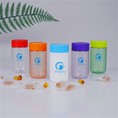Have you ever noticed that vitamin bottles come in many different colors - some clear, some amber, others opaque or tinted? The choice isn't random. In fact, the color of a vitamin bottle plays an important role in product protection, branding, and customer trust.
1. Protecting the Active Ingredients
Vitamins and dietary supplements often contain active ingredients that are sensitive to light, oxygen, and moisture. For example, Vitamin C and B-complex vitamins can lose their potency when exposed to sunlight. That's why most manufacturers and suppliers use darker bottles - such as amber or green - to block out UV and visible light. Even when transparent PET bottles are used, they're usually combined with foil seals or external cartons for added protection.


2. Building Brand Identity and Recognition
Bottle color is not only a functional choice but also a branding strategy. A factory might select colors based on the product's target audience: bright-colored bottles for children's vitamins, and darker tones for adult supplements to convey professionalism and reliability. Visually distinctive packaging helps customers recognize the product instantly - especially on crowded online marketplaces.
3. Ensuring Product Safety and Stability


Certain vitamins can undergo chemical reactions when exposed to light or heat in clear or light-colored bottles, leading to discoloration or odor. Responsible manufacturers choose materials like HDPE or PET with excellent stability and pair them with suitable bottle colors to minimize such risks. For the factory, this is not only about quality assurance but also about reducing returns and protecting brand reputation.
4. Enhancing User Experience
Color also affects how customers perceive and use the product. Dark bottles give a sense of safety and reliability, while clear or semi-transparent bottles allow users to see the contents inside - which helps build confidence in product quality. A thoughtful design that balances protection with aesthetics creates a better overall experience.
Conclusion
The color of a vitamin bottle is far from a simple design choice - it's a scientific and marketing decision that impacts product stability, safety, and customer perception. Understanding these details helps buyers make smarter decisions when sourcing packaging, and helps every manufacturer, supplier, or factory stand out in a competitive market.





